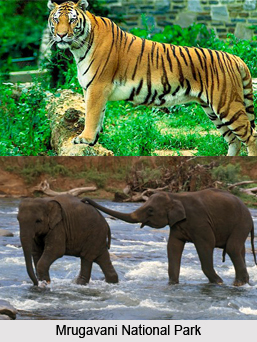 Mrugavani National Park is a wildlife refuge situated in Hyderabad, the common capital of the Indian states Telangana and Andhra Pradesh. It lies in Chilkur in Moinabad Mandal near Andhra Pradesh Police Academy encompassing an area of 700 acres or 3.5 square miles. The place exhibits an urban forest eco-system which shelters a rich biodiversity and offers an experience of enchanting wilderness. Mrugavani National Park was notified in 1994 by the Government of India. Human disturbances and intervention is strictly monitored in the park to provide ideal environment for the wild animals.
Mrugavani National Park is a wildlife refuge situated in Hyderabad, the common capital of the Indian states Telangana and Andhra Pradesh. It lies in Chilkur in Moinabad Mandal near Andhra Pradesh Police Academy encompassing an area of 700 acres or 3.5 square miles. The place exhibits an urban forest eco-system which shelters a rich biodiversity and offers an experience of enchanting wilderness. Mrugavani National Park was notified in 1994 by the Government of India. Human disturbances and intervention is strictly monitored in the park to provide ideal environment for the wild animals.
Geography of Mrugavani National Park
The topography of Mrugavani National Park constitutes rocky exposures which are characteristic of Deccan formation. The temperature of the region varies from 11 and 40 degree Celsius and it receives an annual rainfall of 750 cm.
Flora and Fauna of Mrugavani National Park
Mrugavani National Park is mainly covered with southern tropical dry deciduous forests, scattered with woodlands and grasslands. Several endemic species of flora of Hyderabad region are also found here. About 600 plant species have been recorded here including various herbs and shrubs. Common floras which grow in the park include Rela, Palas, Picus, Sandal, Bamboo, Teak and many more. The park also shows huge diversity in terms of its faunal population. It is inhabited by Cobra, Russell`s viper, Python, Monitor Lizard, Mongoose, Civet Cat, Jungle Cat, Wild Boar, Sambar, Cheetal, Indian Hare and other species. Common birds which flock around the park are Black Drongo, Little Egret, Pond Heron, Indian Robin, Green Bee-Eater, Red Vented Bulbul, Peafowl, Quail, Grey Partridge and many more. The population of butterflies in the forest is fascinating and comprises Crimson Tip, Common Pierrot, Common Emigrant, Plain Orange Tip etc.
Visiting Information
Mrugavani National Park is situated at a distance of 25 kilometres from the main city of Hyderabad and can be easily approached by road. Cottages and tents in the park provide comfortable accommodations to the tourists. The place can be visited all round the year. Jungle safari can be opted to have a close rendezvous with the nature. There is also a watch tower inside the park which offers a panoramic view of the vibrant wildlife around. It also houses an Environmental Education Centre, a well stocked library and a museum.



















